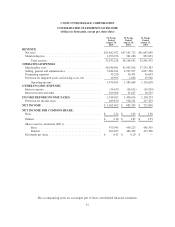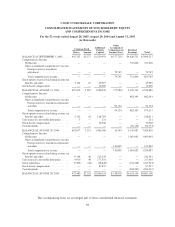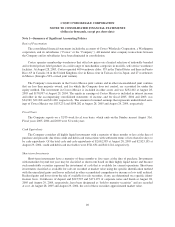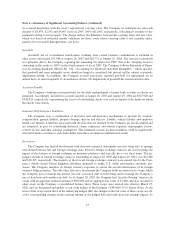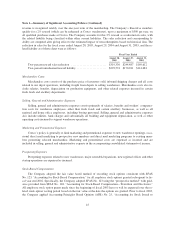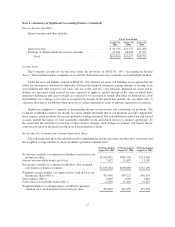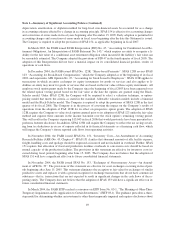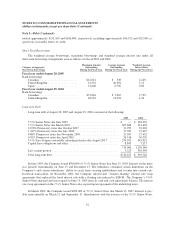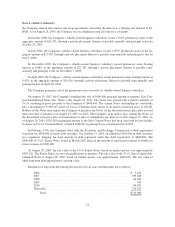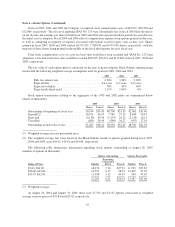Costco 2005 Annual Report Download - page 46
Download and view the complete annual report
Please find page 46 of the 2005 Costco annual report below. You can navigate through the pages in the report by either clicking on the pages listed below, or by using the keyword search tool below to find specific information within the annual report.
Note 1—Summary of Significant Accounting Policies (Continued)
revenue is recognized ratably over the one-year term of the membership. The Company’s Executive members
qualify for a 2% reward (which can be redeemed at Costco warehouses), up to a maximum of $500 per year, on
all qualified purchases made at Costco. The Company accounts for this 2% reward as a reduction in sales, with
the related liability being classified within other current liabilities. The sales reduction and corresponding li-
ability are computed after giving effect to the estimated impact of non-redemptions based on historical data. The
reduction in sales for the fiscal years ended August 28, 2005, August 29, 2004 and August 31, 2003, and the re-
lated liability as of those dates were as follows:
Fiscal Year Ended
August 28,
2005
August 29,
2004
August 31,
2003
Two-percent reward sales reduction ......................... $319,336 $244,487 $169,612
Two-percent unredeemed reward liability ..................... $229,574 $170,941 $114,681
Merchandise Costs
Merchandise costs consist of the purchase price of inventory sold, inbound shipping charges and all costs
related to our depot operations, including freight from depots to selling warehouses. Merchandise costs also in-
clude salaries, benefits, depreciation on production equipment, and other related expenses incurred in certain
fresh foods and ancillary departments.
Selling, General and Administrative Expenses
Selling, general and administrative expenses consist primarily of salaries, benefits and workers’ compensa-
tion costs for warehouse employees, other than fresh foods and certain ancillary businesses, as well as all
regional and home office employees, including buying personnel. Selling, general and administrative expenses
also include utilities, bank charges and substantially all building and equipment depreciation, as well as other
operating costs incurred to support warehouse operations.
Marketing and Promotional Expenses
Costco’s policy is generally to limit marketing and promotional expenses to new warehouse openings, occa-
sional direct mail marketing to prospective new members and direct mail marketing programs to existing mem-
bers promoting selected merchandise. Marketing and promotional costs are expensed as incurred and are
included in selling, general and administrative expense in the accompanying consolidated statements of income.
Preopening Expenses
Preopening expenses related to new warehouses, major remodels/expansions, new regional offices and other
startup operations are expensed as incurred.
Stock-Based Compensation
The Company adopted the fair value based method of recording stock options consistent with SFAS
No. 123, “Accounting for Stock-Based Compensation,” for all employee stock options granted subsequent to fis-
cal year end 2002. Specifically, the Company adopted SFAS No. 123 using the “prospective method” with guid-
ance provided from SFAS No. 148, “Accounting for Stock-Based Compensation—Transition and Disclosure.”
All employee stock option grants made since the beginning of fiscal 2003 have or will be expensed over the re-
lated stock option vesting period based on the fair value at the date the options are granted. Prior to fiscal 2003,
the Company applied Accounting Principles Board Opinion (APB) No. 25, “Accounting for Stock Issued to
45




